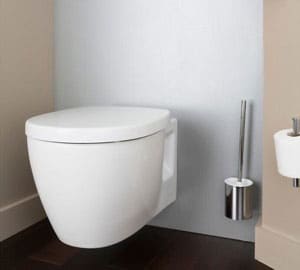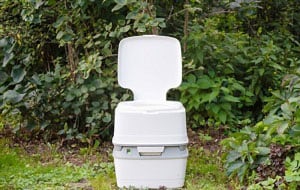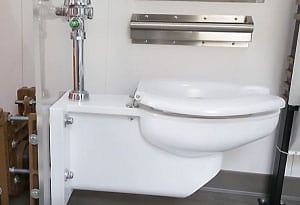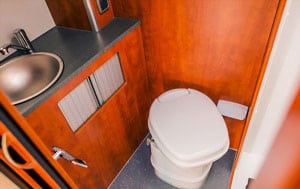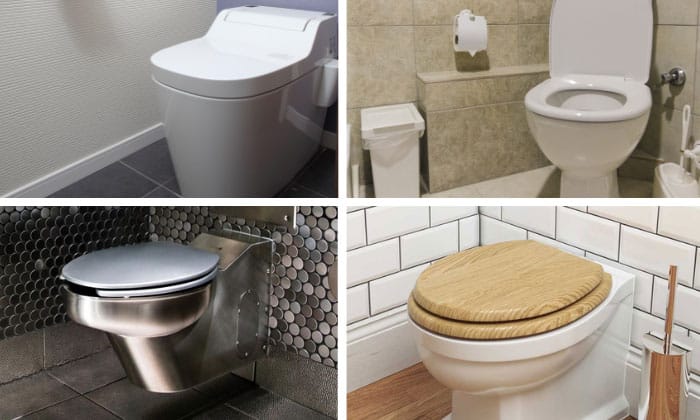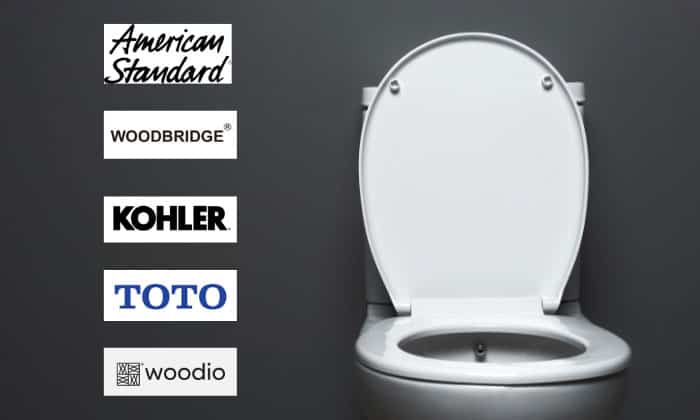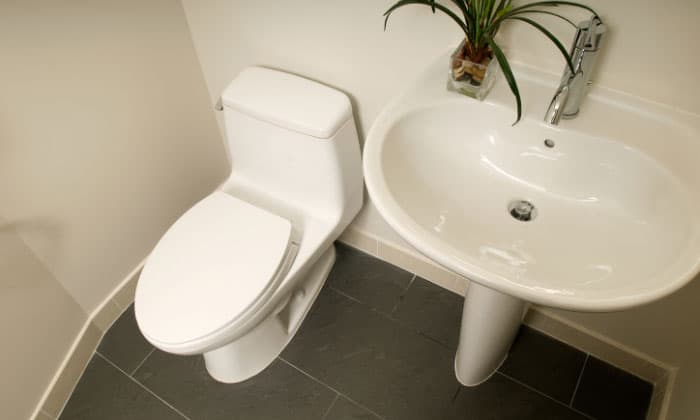In picking a toilet bowl for our bathroom, aside from the aesthetic features, we should also check how much weight can a toilet hold. To use it, we have to sit on it, right?
On average, a floor-mounted or standard toilet can hold 1000 pounds. A wall hung toilet, on the other hand, can hold half that.
In this article, we will cover more about the weight capacity of different toilets, some trusted brands, and the materials they’re made of.
Table of Contents
What Is My Commode’s Weight Capacity?
There are different types of commodes; we have the floor-mounted or the typical toilet you would find anywhere, the wall-mounted, portable, bariatric, and even an RV toilet.
Their toilet weight limit may vary, but don’t worry— we will discuss everything in this section.
Types of Toilets
1. Floor-Mounted or Standard Toilet
Also the most common toilet, this one sits and is screwed on the floor with a flange and wax ring.
A standard toilet can hold up to 1000 pounds of weight, or 454 kilos. Unless you hold the Guinness World Record for being the heaviest man—who was 1,310 pounds or 595 kilos in 2017— then a floor-mounted toilet is strong enough for almost everyone.
But even so, can a fat person break a toilet? It is very unlikely because porcelain is highly durable, especially if it has the support of the floors.
2. Wall-Mounted or Floating Toilet
A wall-mounted toilet is hung on the wall, and the tank is hidden behind the wall as well.
The floating toilet has a weight capacity of at least 500 pounds or 227 kilos, which is half the capacity of a standard toilet. There are some things that we must consider too in using this type of commode, which are the following:
- Carrier Frame – This is where we hang the floating toilet and is installed behind the walls. The frame’s metal should be strong, and we must make sure to take note of its weight limit.
Carrier frames usually have a weight capacity of 500 to 880 pounds (227 to 399 kilos). Hence, it is better if the toilet itself is not too heavy, in case there will be a weighty person who will be using it.
- Wall Strength – Aside from the wall being strong, it should be thick enough as well. The minimum requirement before installing a floating toilet is a wall thickness of at least 6 inches.
- Toilet Durability – While porcelain itself is a sturdy material, we recommend a wall-hung toilet from a reputable brand to ensure quality.
Read more: Wall hung vs floor mounted toilets: which is better?
3. Portable Toilet
Evident from its name, this toilet can be moved from one place to another, usually by a vehicle. Portable toilets are used for camping or an event in a place with no comfort rooms available.
Having said that, this type of commode may or may not have a flush system. The weight it can hold will vary depending on the brand and model as there are many types; it will be best to know them, so you can correctly choose the portable toilet for heavy person.
Some portable toilets can handle:
- 300 pounds or 136 kilos (Camco Portable Toilet Bucket)
- 400 pounds or 141 kilos (BLIKA Portable Toilet for Camping)
- 500 pounds or 227 kilos (GO Anywhere Portable Toilet)
Read more: Portable toilet vs restroom trailer: what is the difference?
4. Bariatric Toilet
This type of toilet is specifically designed for people with disabilities and those who are obese. We will mostly find bariatric toilets in healthcare facilities, and they are tested to hold up to 2,205 pounds or 1000 kilos, depending on the brand and specifications.
If you are worried that standard toilet seats crack because of big users, find a bariatric toilet that can hold at least 1,200 pounds or 544 kilos.
5. RV Toilet
A recreational vehicle or RV is used to go to different locations that sometimes do not have a public restroom. That is why we have an RV toilet that is normally made of plastic, and this can hold 270 to 300 pounds (122 to 136 kilos).
We also have porcelain ones, and how much weight can a porcelain toilet hold? Up to 1000 pounds (454 kilos) is the answer. However, this will add too much weight to the RV.
Materials Used in Manufacturing Toilets
1. Porcelain
Porcelain toilets are the most common in households and commercial establishments. They are:
- sturdy and durable
- fully waterproof
- easy to maintain
- comfortable to use
2. Stainless Steel
Toilets made of stainless steel are durable. Hence, bariatric toilets use this material as well. They are also used in institutional or commercial places, but the challenge with stainless steel is its:
- susceptibility to scratch
- sensitivity to temperature changes
3. Plastic
Portable toilets or “porta potties” are usually made of polyurethane plastic, since it is cheaper and lighter than porcelain, which makes it suitable for recreational vehicles or RVs. Polyurethane plastic is:
- easy to clean
- hygienic and doesn’t absorb bad odor
Plastic may not be the strongest toilet seat, but it has a longer lifespan and is easier to clean well compared to wooden ones.
4. Wood
Although rare, there are new toilets made of wood composite that are waterproof, sustainable, and offer more aesthetic designs.
There are also wooden toilet seats that are durable and offer a different look in the bathroom, but the challenge is that they are:
- more difficult to clean than plastic toilet seats
- can rot over time
Different Brands of Toilets
1. American Standard Brands
An American Standard toilet is one of the most reliable, as it can last for 10 to 15 years with proper care and maintenance. The brand was a result of its older companies merging back in 2008 and is also offering other bathroom and kitchen fixtures.
Usually, this type of commode holds 300 pounds without trouble, but bariatric versions will accommodate 2,000 pounds.
2. Kohler
Another reputable toilet brand, Kohler started offering plumbing products in 1883. Its toilets are reportedly more water-efficient than American Standard’s. Kohler toilets will also support up to 1,000 pounds.
3. TOTO Ltd.
Founded in 1917, TOTO Ltd. provides sinks, faucets, and other bathroom products. TOTO toilets have a higher flushing capability with a class 6 flush and 1 gallon per flush.
They are also priced more competitively than American Standard and Kohler, and their weight limit is about 880 pounds.
4. Woodio Oy
Woodio is a Finland-based bathroom supply store that showcases sustainable, durable, and aesthetically modern products. Its toilets are made of solid wood composite and resin, the first brand to make commodes from such materials.
The brand doesn’t state its product’s weight limit, but wooden toilet seats often handle up to 300 pounds.
5. WoodBridge Bath
WoodBridge has quality kitchen and bathroom fixtures that are known for their reasonable prices.
Despite being a young brand, it offers different types of toilet technology—such as automatic flushing and foot sensors—that can function on par with known trademarks.
Woodbridge toilets can hold up to 1000 pounds.
Frequently Asked Questions (FAQs)
Can an Overweight Person Break a Toilet?
It is improbable for an overweight person to break a toilet, since floor-mounted toilets can handle up to 1000 pounds or 454 kilos.
However, we do have bariatric toilets that can sustain more weight for patients with obesity. Plus, they are more comfortable and safer to use.
What Is a Toilet Seat’s Weight Limit?
A toilet seat’s weight limit will depend on the brand and model. The standard weight capacity is 200 to 300 pounds (91 to 136 kilos), but there are also toilet seats made to withstand more load.
Big John Products, Inc. offers toilet seats that can handle 1,200 pounds or 544 kilos, ideal for bariatric patients.
Conclusion
A toilet bowl is an essential tool for comfort and functionality, which is why we must know how much weight can a toilet hold.
A commode’s weight capacity will depend on its type. For instance, a standard toilet can handle 1000 pounds with the support of the flooring as the base.
Wall-hung or floating toilets can carry 500 pounds, while RV toilets max out at around 200 to 300 pounds (or more if made of porcelain). Lastly, bariatric toilets hold up to 1,200 pounds, and portable toilets can withstand 300 to 500 pounds.

I’m Paulk Webb, and I work as a writer for Saveourwaterrebates. I’m happy to put in the time and effort to conduct market research to identify the most pressing issues faced by households concerning their plumbing. Feel free to check out our guides to get the most informed recommendations for how to solve your problems.




